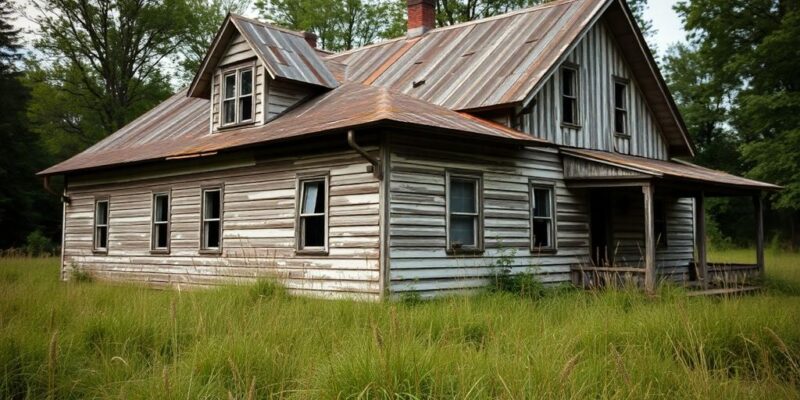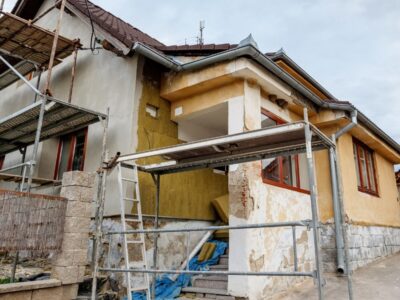Historical Use of Asbestos in Farmhouses
Asbestos was once a popular material in construction, particularly in the early to mid-20th century. It was valued for its durability, fire resistance, and insulation properties. Many older farmhouses, especially those built before the 1980s, incorporated asbestos in various forms. Common applications included insulation for pipes, roofing shingles, floor tiles, and even in some paints and adhesives. The widespread use of asbestos during this period means that many farmhouses are still at risk today.
Health Implications of Asbestos Exposure
Exposure to asbestos fibers can lead to serious health issues. When asbestos-containing materials are damaged or disturbed, tiny fibers are released into the air. Inhaling these fibers can cause diseases such as asbestosis, lung cancer, and mesothelioma. Mesothelioma is particularly aggressive and often linked directly to asbestos exposure. The health risks associated with asbestos are significant, and prolonged exposure increases the likelihood of developing these conditions.
Why Older Farmhouses Are at Risk
Older farmhouses are particularly vulnerable to asbestos-related issues for several reasons:
- Age of Construction: Many were built during the peak years of asbestos use, making them more likely to contain asbestos materials.
- Wear and Tear: Over time, building materials can deteriorate, increasing the chances of asbestos fibers being released.
- Lack of Awareness: Homeowners may not be aware of the presence of asbestos, especially if they have not conducted professional inspections.
Farmers and residents must remain vigilant, as the risk of asbestos exposure is not isolated to urban areas. In fact, farmers may face asbestos exposure in their daily activities, which can increase their risk of developing serious health conditions. Understanding these risks is crucial for ensuring the safety of those living in and working around older farmhouses.
Identifying Asbestos in Older Farmhouses
Common Locations of Asbestos in Farmhouses
Older farmhouses can harbor asbestos in various unexpected places. Asbestos was frequently used in roofing materials, insulation, and even in some floor tiles. It’s not uncommon to find asbestos in cement board siding or around steam pipes. In farmhouses, it might also be present in the panels between wallboards or in corrugated roofing. Other potential hotspots include rainwater pipes and gutters. The key is knowing where to look.
Visual Indicators of Asbestos Presence
While you can’t always rely on sight alone, some visual clues might suggest the presence of asbestos. For instance, asbestos materials might appear as a light grey or even a blue hue, depending on the type. You might notice powdering or flaking on surfaces that are worn or damaged. However, bear in mind that a visual inspection is not a definitive method for identifying asbestos. If you suspect asbestos, it’s crucial to collect samples and send them to a certified testing facility for confirmation.
Professional Asbestos Surveys
To accurately identify asbestos, a professional survey is recommended. These surveys are conducted by experts who can safely assess and handle potential asbestos-containing materials. They can pinpoint the exact locations of asbestos and determine the best course of action for management or removal. Hiring professionals ensures that the process is thorough and minimizes the risk of asbestos exposure to residents. It’s a step that provides peace of mind and ensures safety in older farmhouses.
Are Older Farmhouses More Likely to Have Asbestos?
Factors Contributing to Asbestos Presence
Older farmhouses, especially those built before the 1980s, are often more likely to contain asbestos. This is largely due to the widespread use of asbestos in building materials during that era. Asbestos was commonly used due to its durability and resistance to heat. Over time, these materials can deteriorate, releasing harmful fibers into the air.
Several factors contribute to the presence of asbestos in these structures:
- Age of the Building: Structures built before the 1980s are more likely to have asbestos-containing materials.
- Type of Materials Used: Asbestos was used in various components such as insulation, floor tiles, and roofing.
- Previous Renovations: Any renovations done without proper asbestos removal may leave behind hazardous materials.
Comparing Farmhouses to Other Structures
Farmhouses are not unique in their potential to harbor asbestos, but they often have distinct characteristics that may increase the likelihood of asbestos presence. Unlike urban homes, farmhouses might have been constructed with more rudimentary materials that commonly contained asbestos. In contrast, newer homes built after the 1980s are less likely to have asbestos due to stricter building codes and regulations.
When comparing farmhouses to other structures:
- Rural vs. Urban Construction: Farmhouses may have used more asbestos-heavy materials compared to urban homes.
- Building Regulations: Urban areas often updated their building codes earlier than rural areas, reducing asbestos use sooner.
- Maintenance Practices: Farmhouses might have less frequent maintenance, allowing asbestos materials to deteriorate.
Statistical Data on Asbestos in Farmhouses
Studies and surveys show that a significant number of older farmhouses still contain asbestos. While exact numbers can vary, it is estimated that a large percentage of homes built before the 1980s, including farmhouses, have some form of asbestos. This is especially true for those that have not undergone major renovations or asbestos abatement processes.
Key statistics include:
- A high percentage of homes from the pre-1980s era contain asbestos in some form.
- Asbestos is most commonly found in insulation, flooring, and roofing materials.
- Homes that have not been updated or renovated are more likely to still contain asbestos.
In summary, older farmhouses often harbor asbestos due to historical building practices. Understanding these factors can help homeowners take the necessary precautions to manage and mitigate asbestos risks.
Health Risks Associated with Asbestos in Farmhouses
Types of Asbestos-Related Diseases
Asbestos exposure is linked to several serious diseases. The most notorious is mesothelioma, a rare cancer affecting the lining of the lungs, abdomen, or heart. Lung cancer is another major risk, often developing years after exposure. Asbestosis, a chronic lung disease, causes scarring of lung tissue, leading to severe respiratory issues. These diseases often have long latency periods, making early detection challenging.
Long-Term Health Impacts
The long-term effects of asbestos exposure can be devastating. Once inhaled, asbestos fibers can remain in the body for decades, silently causing damage. Over time, this can lead to reduced lung function, difficulty breathing, and heart complications. The psychological impact of living with a chronic illness should not be underestimated either, as it can significantly affect quality of life.
Vulnerable Populations
Certain groups are more susceptible to the dangers of asbestos. Older adults, who may have been exposed in their younger years, are at higher risk due to cumulative exposure. Children are particularly vulnerable because their bodies are still developing, and they have a longer life expectancy during which diseases could manifest. Additionally, individuals with pre-existing respiratory conditions may experience more severe health effects from asbestos exposure.
Living in a house with intact asbestos siding is generally safe, as it poses minimal risk when the fibers remain bound. However, any renovation or damage to the materials can increase exposure risk, making awareness and caution vital for all residents.
In summary, while asbestos in farmhouses poses significant health risks, understanding these risks and taking preventive measures can help mitigate potential harm. Regular inspections and professional assessments are key to ensuring safety.
Legal Responsibilities for Asbestos in Farmhouses
Regulations Governing Asbestos in Homes
In many regions, including the UK, the management of asbestos is governed by strict regulations. These laws aim to ensure that asbestos is handled safely to protect public health. For instance, the Control of Asbestos Regulations 2012 (CAR 2012) in the UK, outlines the responsibilities of those who manage or own properties that might contain asbestos. Dutyholders, such as farmhouse owners, are required to identify and manage asbestos in their properties. This includes conducting regular assessments and maintaining records of asbestos locations.
Homeowner Obligations for Asbestos Management
Homeowners are not only responsible for identifying asbestos but also for managing it effectively. This often involves hiring professionals to conduct asbestos surveys and developing management plans to mitigate any risks. If asbestos is found, homeowners must ensure that it is safely contained or removed, following legal guidelines. Informing potential buyers about the presence of asbestos is also a legal requirement when selling a property.
Penalties for Non-Compliance
Failure to comply with asbestos regulations can lead to significant penalties. These can range from fines to legal action, depending on the severity of the breach. It’s essential for homeowners to stay informed about their legal responsibilities and to take proactive steps to manage asbestos risks. For landlords, understanding their legal responsibilities is crucial to avoid potential liabilities and ensure the safety of their tenants.
Safe Asbestos Removal from Farmhouses
Hiring Licensed Asbestos Abatement Professionals
When dealing with asbestos in older farmhouses, it’s crucial to engage professionals who are licensed and experienced in asbestos abatement. Hiring a licensed professional ensures that the removal process adheres to strict safety standards, minimizing health risks. These experts will conduct a thorough inspection, identifying all asbestos-containing materials (ACMs) before crafting a comprehensive removal plan. It’s not just about pulling out the asbestos; it’s about doing it safely and legally.
- Always verify the professional’s credentials and licensing.
- Ensure they follow local and federal regulations for asbestos removal.
- Request a detailed plan and timeline for the removal process.
DIY Asbestos Removal: Risks and Precautions
Attempting to remove asbestos on your own can be tempting to save costs, but it’s fraught with risks. Disturbing ACMs without proper equipment and knowledge can release dangerous fibers into the air, posing severe health hazards. If you’re considering this route, here are some critical precautions:
- Never start without a proper assessment of the area by a professional.
- Use protective gear, including masks and suits, specifically designed for asbestos work.
- Seal off the work area to prevent contamination of other parts of the house.
Cost Implications of Asbestos Removal
The cost of asbestos removal can vary significantly, influenced by factors such as the extent of contamination and the complexity of the removal process. On average, asbestos removal costs range from $1,191 to $3,255, but this can fluctuate based on specific circumstances. It’s essential to get multiple quotes from licensed professionals to understand the financial commitment involved.
- Consider the long-term health benefits versus the immediate cost.
- Factor in potential additional costs for repairs or renovations post-removal.
- Remember that some insurance policies might cover part of the removal costs.
Preventive Measures for Asbestos in Farmhouses
Regular Inspections and Maintenance
Keeping a close eye on the condition of older farmhouses is key to managing asbestos risks. Regular inspections should be scheduled to check for any signs of wear or damage in materials that might contain asbestos. This proactive approach can prevent the release of harmful fibers into the air. During inspections, it’s crucial to focus on areas like roofing, insulation, and pipes, as these are common places where asbestos might be found. If any damage is noticed, it’s important to take immediate action to address it, either through repairs or by consulting professionals.
Asbestos Encapsulation Techniques
When dealing with asbestos materials that are still in good condition, encapsulation can be an effective way to manage them. This process involves applying a sealant to the asbestos-containing material, which prevents fibers from becoming airborne. Encapsulation is often a preferred method because it is less disruptive and can be more cost-effective than removal. However, it’s essential to ensure that the encapsulation is done by trained professionals who can guarantee that the seal is secure and will not degrade over time.
Educating Residents on Asbestos Risks
Awareness is a powerful tool in managing asbestos risks. Educating those who live in or frequently visit older farmhouses about the dangers of asbestos and the importance of not disturbing potential asbestos-containing materials is crucial. Residents should be informed about the visual indicators of asbestos presence, such as flaking or powdering on surfaces, and understand the importance of not attempting DIY removal. Providing resources on what to do if asbestos is suspected can empower residents to take the necessary precautions, such as seeking professional help. This knowledge not only protects the health of the residents but also ensures compliance with safety regulations.
Impact of Asbestos on Farmhouse Renovations
Challenges in Renovating Asbestos-Containing Farmhouses
Renovating an old farmhouse can be a rewarding yet daunting task, especially when asbestos is involved. Asbestos, once a popular building material, can pose significant health risks if not handled properly. The challenge lies in identifying and managing asbestos-containing materials (ACMs) without disrupting them, which could release harmful fibers into the air. Renovators must carefully plan their projects, ensuring they comply with safety regulations and minimize exposure risks. This often involves hiring professionals to conduct surveys and possibly delaying renovations if ACMs are found.
Cost Considerations for Asbestos Management
The financial aspect of dealing with asbestos in farmhouse renovations can be substantial. Homeowners need to consider:
- Inspection Costs: Hiring professionals to identify asbestos presence.
- Removal Expenses: Engaging licensed abatement experts to safely remove or encapsulate asbestos materials.
- Project Delays: Potential postponements in renovation timelines, which can lead to increased labor and material costs.
These costs can add up quickly, making it essential for homeowners to budget accordingly and explore financing options if necessary.
Balancing Preservation and Safety
Farmhouses often hold historical and sentimental value, making preservation a priority for many owners. However, the presence of asbestos necessitates a careful balance between maintaining the farmhouse’s character and ensuring the safety of its occupants. Preservation efforts might involve using modern materials that mimic the original ones but without the associated health risks. It’s crucial for homeowners to work with experts who understand both the historical significance and the safety requirements involved in such renovations. By doing so, they can achieve a harmonious blend of old charm and modern safety standards.
Case Studies of Asbestos in Farmhouses
Successful Asbestos Removal Projects
In recent years, there have been several noteworthy asbestos removal projects in older farmhouses. For instance, a farmhouse in rural Pennsylvania underwent a comprehensive asbestos abatement process. The owners discovered asbestos in the insulation, roofing, and flooring materials. They hired a licensed asbestos abatement team, who meticulously removed the hazardous materials. This project not only ensured the safety of the residents but also preserved the farmhouse’s historical integrity. The successful completion of this project serves as a model for similar endeavors.
Another example is a farmhouse in the UK, where asbestos was found during a routine inspection. The discovery led to an extensive removal process, which involved sealing off the affected areas and using specialized equipment to safely extract the asbestos. The project was completed on time and within budget, highlighting the importance of professional intervention in managing asbestos risks.
Lessons Learned from Asbestos Incidents
Analyzing past asbestos incidents in farmhouses provides valuable insights into effective management strategies. One key lesson is the importance of early detection. Regular inspections can identify asbestos presence before it becomes a significant health risk. Additionally, engaging professional services for asbestos surveys and removal is crucial. DIY attempts often lead to improper handling, increasing exposure risks.
Another lesson is the need for clear communication with all stakeholders. Informing residents and workers about potential asbestos hazards and safety measures is essential. This transparency ensures that everyone is aware of the risks and can take appropriate precautions.
Community Responses to Asbestos Discoveries
Community reactions to asbestos discoveries in farmhouses vary, but they often lead to increased awareness and advocacy for safer practices. In some cases, local governments have initiated educational campaigns to inform residents about asbestos risks and management. These campaigns emphasize the importance of professional assessments and removal services.
In areas where asbestos has been a recurring issue, community groups have formed to share resources and support affected families. These groups provide a platform for discussing best practices and advocating for stricter regulations on asbestos management. The collective response underscores the community’s role in addressing environmental health concerns.
In 2009, the EPA discovered asbestos in areas affected by a fire, highlighting ongoing concerns about environmental safety. Similarly, Casa Environmental Services conducted a demolition survey at a site intended for new homes, underscoring the importance of thorough inspections in redevelopment projects.
The Future of Asbestos in Farmhouses
Trends in Asbestos Regulation and Management
In the coming years, asbestos regulations are expected to tighten further, reflecting a global push towards safer living environments. Governments worldwide are increasingly recognizing the health risks posed by asbestos, leading to more stringent laws and regulations. This means that older farmhouses, which often have asbestos-containing materials, will likely fall under closer scrutiny. Homeowners may need to adhere to new guidelines, ensuring that any renovations or demolitions are conducted safely and legally. Moreover, there could be increased financial support for homeowners needing to manage asbestos in their properties, making compliance more accessible.
Innovations in Asbestos Detection and Removal
Advancements in technology are paving the way for more efficient asbestos detection and removal methods. New tools and techniques are being developed to identify asbestos with greater accuracy, minimizing the disruption and cost associated with traditional surveys. For instance, non-invasive scanning technologies might soon become commonplace, allowing for quick assessments without damaging structures. On the removal front, innovative materials and methods are being researched to safely encapsulate or eliminate asbestos fibers, reducing the risk of exposure during the process. These innovations not only promise to make asbestos management more effective but also more affordable for the average homeowner.
The Role of Technology in Asbestos Safety
Technology is set to play a crucial role in enhancing asbestos safety in farmhouses. From mobile apps that guide homeowners through DIY inspections to advanced filtration systems that reduce airborne fibers, tech solutions are becoming integral to managing asbestos risks. Additionally, digital platforms could facilitate better communication between homeowners and professionals, ensuring that any asbestos-related concerns are addressed promptly. As these technologies evolve, they will likely become indispensable tools in maintaining the safety and integrity of older farmhouses. Embracing these advancements can help homeowners stay ahead of potential hazards, ensuring their properties remain safe and compliant with evolving regulations.
Additional Links
Robert King Mesothelioma Law Services








Comments